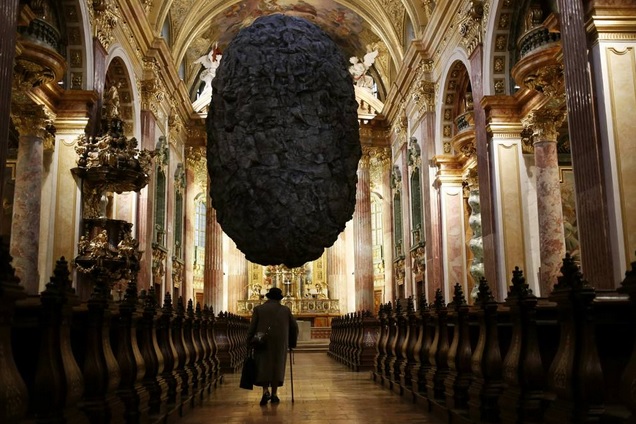
James Tissot, The Merchants Chased from the Temple (Les vendeurs chassés du Temple), 1886-1894. Opaque watercolor over graphite on gray wove paper, Image: 7 5/16 x 11 9/16 in. (18.6 x 29.4 cm). Brooklyn Museum. | Steinbrener/Dempf & Huber To be in big Limbo, Jesuit Church of Vienna, 2015.
Are we going to see an upsurge of Christian Art?
The Protestant Reformation happened in Germany (October 1517) when Martin Luther (then Catholic) nailed his Ninety-Five Theses to the door of the Wittenberg Church. The document heavily criticized the Church and the papacy, the selling of indulgences (tickets for heaven) and rejected doctrinal guidelines about purgatory, limbo and papal authority. Hence the birth of Protestantism, with mobs shouting for radical changes and subsequent religious wars and the destruction of religious art.
Rome was not happy at all. Roman Catholicism was losing big time and many of its sheep was moving to the new herd. Numerous meetings of all the bishops in Trent held between 1545 and 1563 would instigate a response to the Protestant Reformation, consequently the Counter-Reformation. To help in this “war”, God’s soldiers showed up, the Jesuits, a religious order founded in 1539. This was followed by more conflicts and the birth of a new religious art which aimed to be direct and compelling, capable of fostering piety and understandable to everyone.
Now today! Undoubtedly, since the election of the actual Pope Francis I (a Jesuit) the Vatican is living a commotion just as what happened in Europe in 1517. And yet, it is not a Protestant who is creating havoc, but a Roman Catholic, the Pope himself. We are currently in the beginning of the Second Reformation but from within the Vatican itself. Like Luther, he is fighting the Vatican establishment as it is documented in the very new book Merchants in the Temple by the Italian journalist Gianluigi Nuzzi published this past November 16. The publication denounces the outrageous practices of the Vatican bank, religious avarice, professional robbery, expensive cardinal apartments, etc. Not only is the Pope confronting all these issues, but also trying at his very best to simplify the ways of the Church just as Luther did in Saxony.
The Council of Trent dictated new objectives for religious art to make it more direct and compelling in representing the distinctive aspects of Catholic dogma. In order to rebuild confidence and respect for the authority of the Roman Catholic Church, today’s artists have to do the same thing but by underlining its absurdities, hence a paradox. The new reformers (Lutheran and Jesuitical in spirit) through installations, paintings, video, and performances have to reveal the new scandals happening in the Temple of the Holy See: avarice, mismanagement, secret investments, all which may lead to deeper intrigues that need to be revealed.
In this new upheaval of the 21st century Church, artists and social media are the mobs of the 16th century. To show this, Steinbrener/Dempf & Huber created a few months ago an astonishing and surreal work entitled To be in big Limbo currently at the Jesuit Church of Vienna. Is it the representation of a meteorite from Heaven going through the vault of the Church? The fact that it refers to the limbo, a concept fully rejected by Luther, could the sculpture be a manifestation of this Lutheran refutation leading to the destruction of the Church itself? One offended blogger wrote, “only Jesuits could allow into their church something that makes the faith look like a piece of…” “Ah! Those damn Jesuits” as it was so many times written.
A Second Reformation is being on its way, under the leadership of a Jesuit, and being accomplished by everyone through social media and, of course, though art, since artists often have the sensibility to grasp the future.


0 Comments